Conroe Buying Guide: Feeding the Monster
by Gary Key & Wesley Fink on July 19, 2006 6:20 AM EST- Posted in
- Motherboards
General Performance
The PCMark05 benchmark, developed by Futuremark, was designed for determining overall system performance for the typical home computing user. This tool provides both system and component level benchmarking results utilizing subsets of real world applications or programs. This benchmark is useful for providing comparative results across a broad array of graphics cards, CPUs, hard disks, and memory configurations and it also includes some multithreading results. In this sense we consider the PCMark benchmark to be both synthetic and real world in nature while providing consistency in our benchmark results.
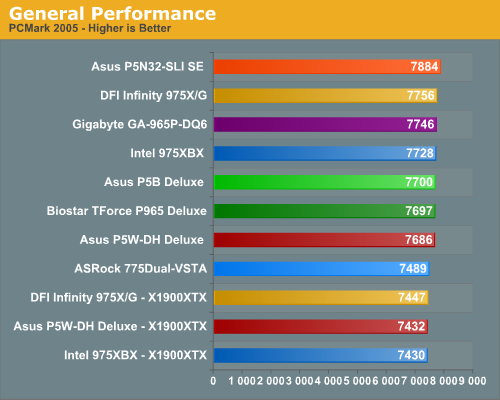
PCMark 2005 results for our test group are fairly close between the Intel chipset boards with the NVIDIA based ASUS P5N32-SLI SE taking a solid lead here due to excellent hard drive performance and multitasking scores within the benchmark. The three ATI X1900XTX equipped boards finished at the bottom of the group due to weak score results in the 2D benchmarks. Despite the close results in these tests with the Intel chipset boards, PCMark05 is still proving to be a useful overall performance benchmark. It is generally more sensitive than the older Winstones and PCMark04 to recent improvements in PC architecture.
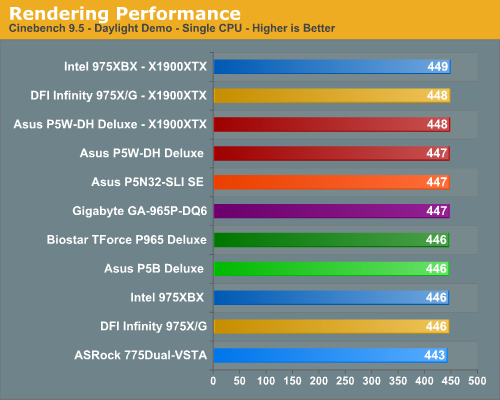
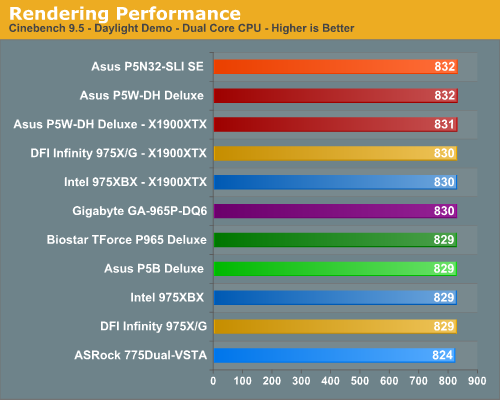
We have replaced Winstones with 2 benchmarks that use rendering to test system performance. Cinebench 9.5 heavily stresses the CPU subsystem while performing graphics modeling and rendering. We utilize the standard benchmark demo within the program along with the default settings. Cinebench 9.5 features two different benchmarks with one test utilizing a single core and the second test showcasing the power of multiple cores in rendering the benchmark image.
While results are generally close in Cinebench, the ASUS P5N32-SLI SE tops the Dual-Core test results with the Intel 975XBX finishing a strong first in the single core tests, followed closely by the ASUS P5W-DH in both tests.
The 3DMark series of benchmarks by Futuremark are among the most widely used tools for benchmark reporting and comparisons. Although the benchmarks are very useful for providing apple to apple comparisons across a broad array of GPU and CPU configurations, they are not a substitute for actual application and gaming benchmarks. In this sense we consider the 3DMark benchmarks to be purely synthetic in nature but still valuable for providing consistent measurements of performance.
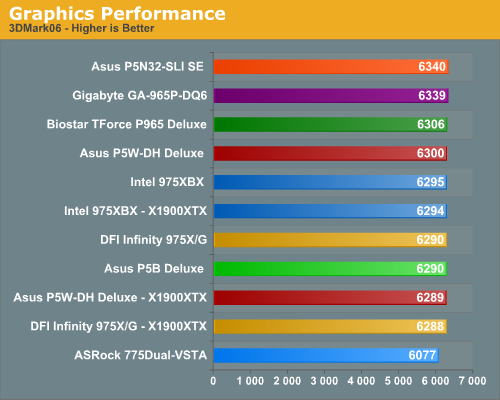
After taking a very strong first place in PCMark2005, we see the ASUS P5N32-SLI SE squeaking out a win in the 3DMark06 with an excellent performance turned in by the Gigabyte GA-965P-DQ6 for second place. The performance of the entire group was very close with the exception of the ASRock board due to its PCIe implementation (although a score over 6000 is still very respectable). The surprise was the ATI X1900XTX GPU scores as they have historically scored better in this benchmark than the NVIDIA based 7900GTX cards. We are still having conversations with ATI, but there appears to be a driver issue with the Core 2 Duo processors in our testing as the game scores will reflect the same results.
Overclocking Comparison
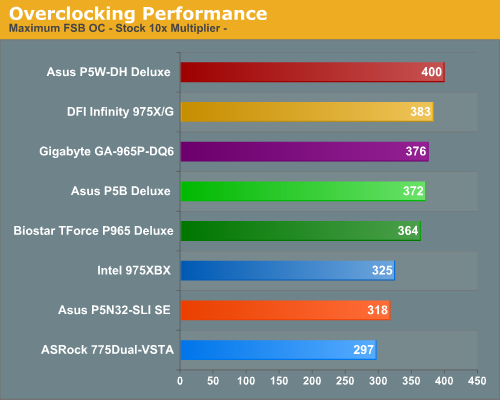
The overclocking capabilities we have measured thus far are with our standard E6700 CPU at a 10X multiplier. While this will not show the true FSB potential of the board, it does show a board's capability with the second highest performing Core 2 Duo and what can be expected with the fixed multiplier CPUs on average. We will be providing FSB overclocking results in our individual board reviews with the unlocked X6800. However, the only board in our testing that exceeded a 400FSB was the ASUS P5W-DH that reached 445MHz with our amazing little E6600 before running out of MCH voltage.
The NVIDIA based ASUS P5N32-SLI SE turned in a decent overclocking performance for an NVIDIA based Intel board but falls far short of the Intel chipset boards in high FSB overclocking. This situation will improve gradually over the next several months with the release of the DFI nF590 SLI board next month and then with the next true chipset revision this winter. Although the nForce4 Intel Edition board did not overclock competitively with the Intel chipsets when utilizing the FSB method, it did match the same overclocks when raising the CPU multiplier with our X6800 CPU.
The PCMark05 benchmark, developed by Futuremark, was designed for determining overall system performance for the typical home computing user. This tool provides both system and component level benchmarking results utilizing subsets of real world applications or programs. This benchmark is useful for providing comparative results across a broad array of graphics cards, CPUs, hard disks, and memory configurations and it also includes some multithreading results. In this sense we consider the PCMark benchmark to be both synthetic and real world in nature while providing consistency in our benchmark results.

PCMark 2005 results for our test group are fairly close between the Intel chipset boards with the NVIDIA based ASUS P5N32-SLI SE taking a solid lead here due to excellent hard drive performance and multitasking scores within the benchmark. The three ATI X1900XTX equipped boards finished at the bottom of the group due to weak score results in the 2D benchmarks. Despite the close results in these tests with the Intel chipset boards, PCMark05 is still proving to be a useful overall performance benchmark. It is generally more sensitive than the older Winstones and PCMark04 to recent improvements in PC architecture.


We have replaced Winstones with 2 benchmarks that use rendering to test system performance. Cinebench 9.5 heavily stresses the CPU subsystem while performing graphics modeling and rendering. We utilize the standard benchmark demo within the program along with the default settings. Cinebench 9.5 features two different benchmarks with one test utilizing a single core and the second test showcasing the power of multiple cores in rendering the benchmark image.
While results are generally close in Cinebench, the ASUS P5N32-SLI SE tops the Dual-Core test results with the Intel 975XBX finishing a strong first in the single core tests, followed closely by the ASUS P5W-DH in both tests.
The 3DMark series of benchmarks by Futuremark are among the most widely used tools for benchmark reporting and comparisons. Although the benchmarks are very useful for providing apple to apple comparisons across a broad array of GPU and CPU configurations, they are not a substitute for actual application and gaming benchmarks. In this sense we consider the 3DMark benchmarks to be purely synthetic in nature but still valuable for providing consistent measurements of performance.

After taking a very strong first place in PCMark2005, we see the ASUS P5N32-SLI SE squeaking out a win in the 3DMark06 with an excellent performance turned in by the Gigabyte GA-965P-DQ6 for second place. The performance of the entire group was very close with the exception of the ASRock board due to its PCIe implementation (although a score over 6000 is still very respectable). The surprise was the ATI X1900XTX GPU scores as they have historically scored better in this benchmark than the NVIDIA based 7900GTX cards. We are still having conversations with ATI, but there appears to be a driver issue with the Core 2 Duo processors in our testing as the game scores will reflect the same results.
Overclocking Comparison

The overclocking capabilities we have measured thus far are with our standard E6700 CPU at a 10X multiplier. While this will not show the true FSB potential of the board, it does show a board's capability with the second highest performing Core 2 Duo and what can be expected with the fixed multiplier CPUs on average. We will be providing FSB overclocking results in our individual board reviews with the unlocked X6800. However, the only board in our testing that exceeded a 400FSB was the ASUS P5W-DH that reached 445MHz with our amazing little E6600 before running out of MCH voltage.
The NVIDIA based ASUS P5N32-SLI SE turned in a decent overclocking performance for an NVIDIA based Intel board but falls far short of the Intel chipset boards in high FSB overclocking. This situation will improve gradually over the next several months with the release of the DFI nF590 SLI board next month and then with the next true chipset revision this winter. Although the nForce4 Intel Edition board did not overclock competitively with the Intel chipsets when utilizing the FSB method, it did match the same overclocks when raising the CPU multiplier with our X6800 CPU.










123 Comments
View All Comments
Beaner - Wednesday, July 19, 2006 - link
Very well-written article guys!Thanks for taking the time to enlighten us all.
Just wanted to point out that the Mushkin Redline sticks can be had right now for $355 AR. At that price, I may just have to grab 'em myself!
ChronoReverse - Wednesday, July 19, 2006 - link
It was pretty much shown that the effect of using memory dividers for Athlon64's was rather minimal while most dividers were more adverse for Netburst.How large of an effect does using memory dividers have on the Conroe?
Wesley Fink - Wednesday, July 19, 2006 - link
The effect of memory dividers is much smaller on Conroe than we saw on Netburst. In fact memory dividers on Conroe behave more like AM2 - probably the result of the "apparent" reduction in latency with the intelligent look-ahead in memory. Core 2 Duo is not Hyper-Transport, so 1:1 (533) tis still theoretically the highest performing setting, but we were hard pressed to find any measurable advantage of 1:1 in most situations.We had tested a number of high-performance dimms on Conroe before we wrote the Buyers Guide, but there just wasn't the time - or room - to include full memory performance data in the Guide. We do have memory reviews in process that will provide specifics to your questions.
We can summarize what we have learned about memory on Conroe so far. DDR2-667 is quite a bit higher in real perfomance than DDR2-400 or DDR2-533 (1:1). We would consider DDR2 to be the minimum memory that should be used with Conroe. Going up from DDR2-667 we found the following - from fastest to DDR2-667. DDR2-1067 4-4-4 is a bit faster than DDR2-800 3-3-3 is a bit faster than DDR2-667 3-2-3. Timings are very important above DDR2-667 and you can give up any performance advantage with slower timings. DDR2-667 is a good match to COnroe bandwidth, and is better perfoming than 533 or 400 by a wider marging than you find above DDR2-667. It also appears Conroe responds better (performs better with increases) to DDR2 bandwidth increases than either Netburst or AM2.
Wesley Fink - Wednesday, July 19, 2006 - link
We would consider DDR2-667 the minimum memory to use with Conroe, and faster timings do generally improve performance.Sunrise089 - Wednesday, July 19, 2006 - link
I would like to know this as well.txt2000 - Wednesday, July 19, 2006 - link
Just wondering, if your going to spend ~$400 on memory if you would be better off with 4GB value DDR or 2GB high performance.Patsoe - Wednesday, July 19, 2006 - link
I suppose that completely depends on your usage pattern. Almost all of my activities fit within 512MB, and probably anything I do fits within 768MB. So getting faster RAM would do more for me than more of it.If you could fill 3GB, then a setup with 2GB will see a lot hard-disk swapping... even a very slow 4GB of RAM will do better in that case.
Andy4504 - Wednesday, July 19, 2006 - link
Anything over 1GB results in the OS addressing your memory differently. Never did the reasearch on how that different addressing affected system performance however.supremelaw - Wednesday, July 19, 2006 - link
http://www.anandtech.com/mb/showdoc.aspx?i=2797&am...">http://www.anandtech.com/mb/showdoc.aspx?i=2797&am...Timing and content were perfect for this article.
And, your earlier article on the nVidia 590 chipset
for Intel also dovetails perfectly: nice photos too.
August+ should be VERY interesting.
Many thanks!
Sincerely yours,
/s/ Paul Andrew Mitchell
Webmaster, Supreme Law Library
http://www.supremelaw.org/">http://www.supremelaw.org/
mobutu - Wednesday, July 19, 2006 - link
"The board was very stable with our X6800 and X6600 Core 2 Duo processors ..."It should have been E6700 (or maybe E6700)